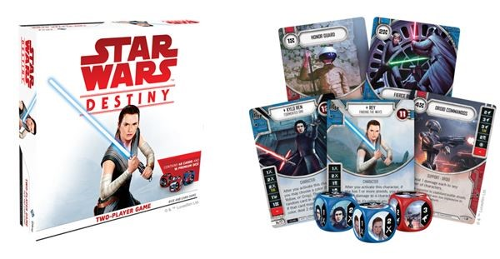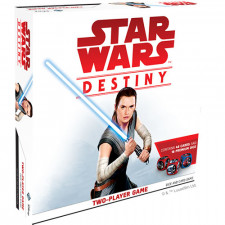Star Wars Destiny: Two-Player Game Review
on Sep 14, 2017
I was late to start with Fantasy Flight's Star Wars: Destiny dice game not only because product was scarce when it came out, but also because I was quite untrusting of a distribution model that seemed to suggest that I really kind of need to get two of an ultra-rare or "legendary" Darth Vader card/die selling for upwards of $30 in the aftermarket o fully experience it. With a new two player starter set released on Force Friday to coincide with the avalanche of Last Jedi goods, I decided to check it out given the near-universal praise it has received, including top marks from at least two of our very own Review Corner writers.
It turns out that I was pretty dumb to sleep on Destiny because it is one of the most concise and subtly designed games that Fantasy Flight has ever released. It is a brilliant dice game/CCG hybrid that just completely pummels Dicemasters so severely that I really think someone should go check on it. It's a dueling game not totally unlike Pokemon or Magic, with more sophistication than the former and less complication than the latter. It is in a sphere with titles such as King of Tokyo and Gekido: Bot Battles but it comes out on top in those contests as well.
The mechanics are supremely simple but of course there is complexity and depth abound in the cards and how they interact with each other. You start out with a few characters - classed as heroes or villains - and these have a die with various actions associated with that character. They might be great at melee or ranged and have symbols on their dice that correspond to that. Or they may be support characters that give you shields, rerolls, resources. Further, they could be disruptive characters that cause other players to discard resources or cards. Your deck of 30 cards (only 20 in this set) contains events, upgrades and supporting characters, vehicles and equipment. When you play upgrades to a character, you add to the dice they get to roll when they are activated whereas support cards add cards with dice of their own.

Guess it's time to join Destiny-Anon.
On your turn, you do one action. You can pay resources to play a card from your hand to the table or trigger an event. Activation means rolling a character's or support's dice and adding them to your pool, and some may have a special ability on activation. Rey, for example, does damage if she has shields when activated. You can discard a card to reroll anything that has gone into your pool. If you run out of things to do, you can claim a central battleground card, which gives you a bonus ability or advantage as well as seizing the initiative for the next turn.
But the key action is resolving your dice pool. When you take this action, you choose one of the icons represented in your current pool and every die with that face showing goes off. So if you want to do a melee attack with Kylo Ren and he's armed with his crossguard lightsaber, look at those dice and add up their melee values. Then you pick a character to wallop with it, with shields reducing the damage. KO all of an opponent's characters and you win. But it's not just about damage - you might want to reroll those dice to try to get an influx of resources to play an expensive card. Or you may need a high shield roll to protect characters perilously low on health.
Matches can progress into some quite compelling tactical puzzles toward the end, with just the right number of branches on the decision tree to make for satisfying depth without overburdening what is otherwise a very accessible, fun-first design. It's approachable and casual enough that my seven year old can play, but it is rich enough to accommodate more serious, competitive play as well.
As for this specific Destiny product, you really couldn't ask for a better starter. It is absolutely a complete two player game in the box, pitting Kylo Ren and Captain Phasma against Rey and Poe Dameron. Each 30 card deck is completely unique, and there are no duplicate cards or dice. I've had a lot of fun playing with just this set, and I actually bought a second one so that I could play with the "elite" versions of the characters- this means you have two of a character's dice to start out with, which is why you need the two $40 Darth Vaders.
With that said, you don't really need the elite upgrade to enjoy this game. This set plays fine by itself and I think most folks would be able to get 10-20 plays out of just what is in it, which at its price point is a great value. But it is true that you don't get enough cards to make an "official" deck, and you are missing the deckbuilding that comes with deeper investment into boosters and singles purchases.
If this set's goal was to get new players interested in the game, it's a total success. If it's just a one-off to allow the curious to check it out, it succeeds there too. For my part, I've taken the plunge and I'm all in on Star Wars: Destiny - two booster boxes cracked and sorted, as it were. It is, ironically, far closer to the kind of Star Wars game I want to play than Rebellion or Imperial Assault were. And now, I'm sniffing around those Empire at War boosters...

 Customer Support
Customer Support  Subscribe
Subscribe 




 Account
Account  Wishlist
Wishlist 

